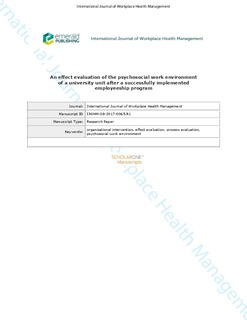| dc.contributor.author | Saksvik, Per Øystein | |
| dc.contributor.author | Færgestad, Margrethe | |
| dc.contributor.author | Fossum, Silje | |
| dc.contributor.author | Olaniyan, Oyeniyi Samuel | |
| dc.contributor.author | Indergård, Øystein | |
| dc.contributor.author | Karanika-Murray, Maria | |
| dc.date.accessioned | 2019-05-08T06:47:32Z | |
| dc.date.available | 2019-05-08T06:47:32Z | |
| dc.date.created | 2018-07-09T12:02:33Z | |
| dc.date.issued | 2018 | |
| dc.identifier.citation | International Journal of Workplace Health Management. 2018, 11 (1), 31-44. | nb_NO |
| dc.identifier.issn | 1753-8351 | |
| dc.identifier.uri | http://hdl.handle.net/11250/2596877 | |
| dc.description.abstract | Purpose
The purpose of this paper is to examine whether a successful implementation of an intervention could result in an effect evaluated independently from a process evaluation. It was achieved by evaluating the effects of an intervention, the “employeeship program,” designed to strengthen the psychosocial work environment through raising employees’ awareness and competence in interpersonal relationships and increasing their responsibility for their everyday work and working environment.
Design/methodology/approach
An employeeship intervention program was developed to improve the psychosocial work environment through reducing conflict among employees and strengthening the social community, empowering leadership, and increasing trust in management. An earlier process evaluation of the program found that it had been implemented successfully. The present effect evaluation supplemented this by examining its effect on the psychosocial work environment using two waves of the organization’s internal survey and comparing changes in the intervention unit at two points and against the rest of the organization.
Findings
The intervention was effective in improving the psychosocial work environment through reducing conflicts among employees and strengthening the social community, empowering leadership, and increasing trust in management.
Research limitations/implications
More attention should be paid to developing and increasing positive psychosocial experiences while simultaneously reducing negative psychosocial experiences, as this employeeship intervention demonstrated.
Practical implications
An intervention focusing on employeeship is an effective way to achieve a healthier psychosocial work environment with demonstrable benefits for individuals and the working unit.
Originality/value
Although organizational-level interventions are complex processes, evaluations that focus on process and effect can offer insights into the workings of successful interventions. | nb_NO |
| dc.language.iso | eng | nb_NO |
| dc.publisher | Emerald | nb_NO |
| dc.title | An effect evaluation of the psychosocial work environment of a university unit after a successfully implemented employeeship program | nb_NO |
| dc.type | Journal article | nb_NO |
| dc.type | Peer reviewed | nb_NO |
| dc.description.version | acceptedVersion | nb_NO |
| dc.source.pagenumber | 31-44 | nb_NO |
| dc.source.volume | 11 | nb_NO |
| dc.source.journal | International Journal of Workplace Health Management | nb_NO |
| dc.source.issue | 1 | nb_NO |
| dc.identifier.doi | 10.1108/IJWHM-08-2017-0065 | |
| dc.identifier.cristin | 1596340 | |
| dc.description.localcode | © 2018. This is the authors' accepted and refereed manuscript to the article. The final authenticated version is available online at: https://doi.org/10.1108/IJWHM-08-2017-0065 | nb_NO |
| cristin.unitcode | 194,67,40,0 | |
| cristin.unitname | Institutt for psykologi | |
| cristin.ispublished | true | |
| cristin.fulltext | original | |
| cristin.fulltext | postprint | |
| cristin.qualitycode | 1 | |
